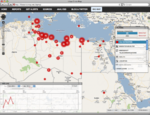Difference between revisions of "Crisis mapping"
Wikidoctor (Talk | contribs) |
|||
| (19 intermediate revisions by 2 users not shown) | |||
| Line 1: | Line 1: | ||
| − | Crisis Mapping displays and analyses data during crises, usually environmental disasters, social and political crises, in real-time. It can be described as combining the components of information collection, visualization and analysis which are within the context of a dynamic, interactive map. | + | Crisis Mapping displays and analyses data during crises, usually environmental disasters, social and political crises, in real-time. It can be described as combining the components of information collection, visualization and analysis which are within the context of a dynamic, interactive map. <ref> [http://irevolution.net/2011/01/20/what-is-crisis-mapping/] Patrick Meier, "What is Crisis Mapping? An Update on the Field and Looking Ahead", iRevoluton </ref> |
==Crisis Mapping Resources== | ==Crisis Mapping Resources== | ||
'''How to meet the information?''' | '''How to meet the information?''' | ||
| + | |||
| + | [[File:Using_the_New_Ushahidi_Platform_to_Crisis_Map_Libya.png | thumb | right | 150px | Using the New Ushahidi Platform to Crisis Map Libya]]<ref> [https://www.ushahidi.com/blog/2011/03/06/using-the-new-ushahidi-platform-to-crisis-map-libya] </ref> | ||
| + | |||
| Line 29: | Line 32: | ||
==Techniques== | ==Techniques== | ||
| − | The tools and methods of crisis mapping are new and rapidly changing. Leveraging both technology and crowd sourcing, passionate participants have been able to provide detailed real time information in places of crisis. In recent years, various techniques are being invented to generate maps and analyze the great quantity of information. | + | The tools and methods of crisis mapping are new and rapidly changing. Leveraging both technology and crowd sourcing, passionate participants have been able to provide detailed real time information in places of crisis. In recent years, various techniques are being invented to generate maps and analyze the great quantity of information. <ref> [http://irevolution.net/2009/03/12/a-brief-history-of-crisis-mapping/] </ref> |
[[File:CM_Timeline_Technology.jpg | Methods and tools for Crisis Mapping]] | [[File:CM_Timeline_Technology.jpg | Methods and tools for Crisis Mapping]] | ||
| Line 36: | Line 39: | ||
==Haiti Earthquake 2010== | ==Haiti Earthquake 2010== | ||
| − | [[File:CM_Haiti_Infografik.jpg | Crisis Mapping in Haiti]] | + | [[File:CM_Haiti_Infografik.jpg | Crisis Mapping in Haiti]] <ref> [http://voices.nationalgeographic.com/2012/07/02/crisis-mapping-haiti] Patrick Meier, "How Crisis Mapping Saved Lives in Haiti", National Geographic, 2012. </ref> |
| + | <ref> [http://www.usip.org/publications/crowdsourcing-crisis-information-in-disaster-affected-haiti] Jessica Heinzelman and Carol Waters, "Crowdsourcing Crisis Information in Disaster- Affected Haiti", United States Institute of Peace, 2010. </ref> | ||
| + | <ref> [http://mediashift.org/2011/01/how-mapping-sms-platforms-saved-lives-in-haiti-earthquake011/] Anne Nelson, "How Mapping, SMS Platforms Saved Lives in Haiti Earthquake", Mediashift, 2011. </ref> | ||
| + | <ref> [http://api.ning.com/files/HX-j3*PqLLSgdkf8w5RVQwTyx-8GN*wEGnr3zb-aZoeXYGoOLSBhU5nFC5-qTSj4C7m7StA0yHmGmHWgdDuDtu48CJRnwW8Q/Ushahidi_Haiti_Eval_final.pdf] Nathan Morrow et al., Independent Evaluation of the | ||
| + | Ushahidi Haiti Project, 2011. </ref> | ||
| + | |||
| + | |||
{{#ev:youtube|https://www.youtube.com/watch?v=pVCC2CB281M}} | {{#ev:youtube|https://www.youtube.com/watch?v=pVCC2CB281M}} | ||
| + | <ref> Patrick Meier, Changing The World, One Map At A Time, TEDxKC, 2011.</ref> | ||
==References== | ==References== | ||
::http://irevolution.net/2011/01/20/what-is-crisis-mapping/ | ::http://irevolution.net/2011/01/20/what-is-crisis-mapping/ | ||
::http://irevolution.net/2009/03/12/a-brief-history-of-crisis-mapping/ | ::http://irevolution.net/2009/03/12/a-brief-history-of-crisis-mapping/ | ||
| − | |||
::http://irevolution.net/2015/10/14/qed-goodbye-doha-hello-adventure/ | ::http://irevolution.net/2015/10/14/qed-goodbye-doha-hello-adventure/ | ||
::http://irevolution.net/2009/03/12/a-brief-history-of-crisis-mapping/ | ::http://irevolution.net/2009/03/12/a-brief-history-of-crisis-mapping/ | ||
| − | :: | + | ::https://www.ushahidi.com/blog/2011/03/06/using-the-new-ushahidi-platform-to-crisis-map-libya |
| − | + | ||
| − | + | ||
Latest revision as of 09:46, 17 November 2015
Crisis Mapping displays and analyses data during crises, usually environmental disasters, social and political crises, in real-time. It can be described as combining the components of information collection, visualization and analysis which are within the context of a dynamic, interactive map. [1]
Crisis Mapping Resources
How to meet the information?
[2]
Call Record Data:
- SMS
- E-Mails
- Phone Calls
Social Media:
- Tweets/Posts
- Text Messages
- Pictures
- Videos
Mainstream Media/Media Coverage:
- Local Media, New York Times, Washington Post, Wall Street Journal, CNN, BBC News, UK Guardian, The Economist, Forbes and Times Magazines, New Yorker, NPR, Wired, Mashable, TechCrunch, Fast Company, Nature, New Scientist, Scientific American and more.
Earth Explorer:
- Satellite
- Aerial Imagery
- Robotics
Humanitarian Partners and volunteers to the rescue:
- Digital Humanitarians
- Translating Needs
- Translate and Geo-Locate text messages
Example Haiti earthquake 2010: Haitian Diaspora joined the cause after hearing about the need for volunteers via Facebook. Engaging people who know the country (location) far better. Engaging the Diaspora. A number of Haitian joined the make-shift “Situation Room” to precise geo-location before they could be added to the map.
Techniques
The tools and methods of crisis mapping are new and rapidly changing. Leveraging both technology and crowd sourcing, passionate participants have been able to provide detailed real time information in places of crisis. In recent years, various techniques are being invented to generate maps and analyze the great quantity of information. [3]
Haiti Earthquake 2010
References
- http://irevolution.net/2011/01/20/what-is-crisis-mapping/
- http://irevolution.net/2009/03/12/a-brief-history-of-crisis-mapping/
- http://irevolution.net/2015/10/14/qed-goodbye-doha-hello-adventure/
- http://irevolution.net/2009/03/12/a-brief-history-of-crisis-mapping/
- https://www.ushahidi.com/blog/2011/03/06/using-the-new-ushahidi-platform-to-crisis-map-libya


